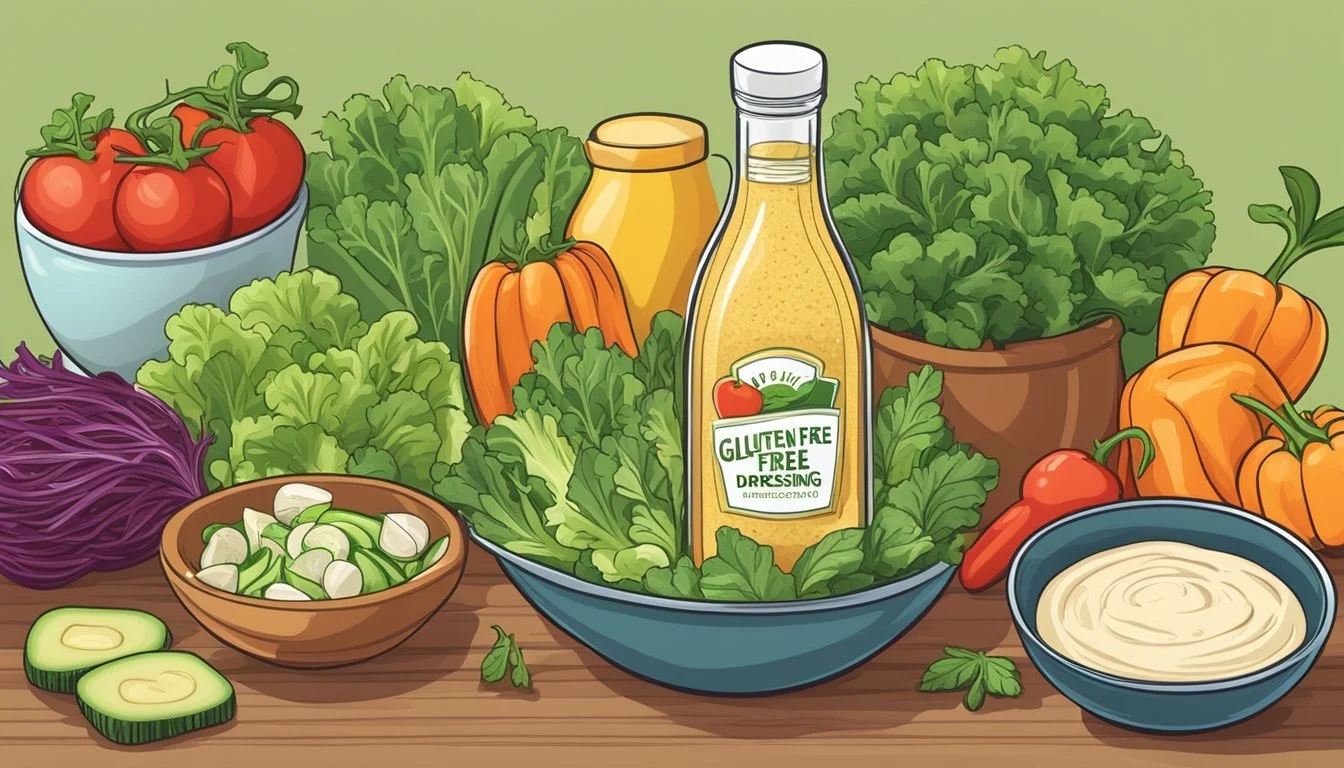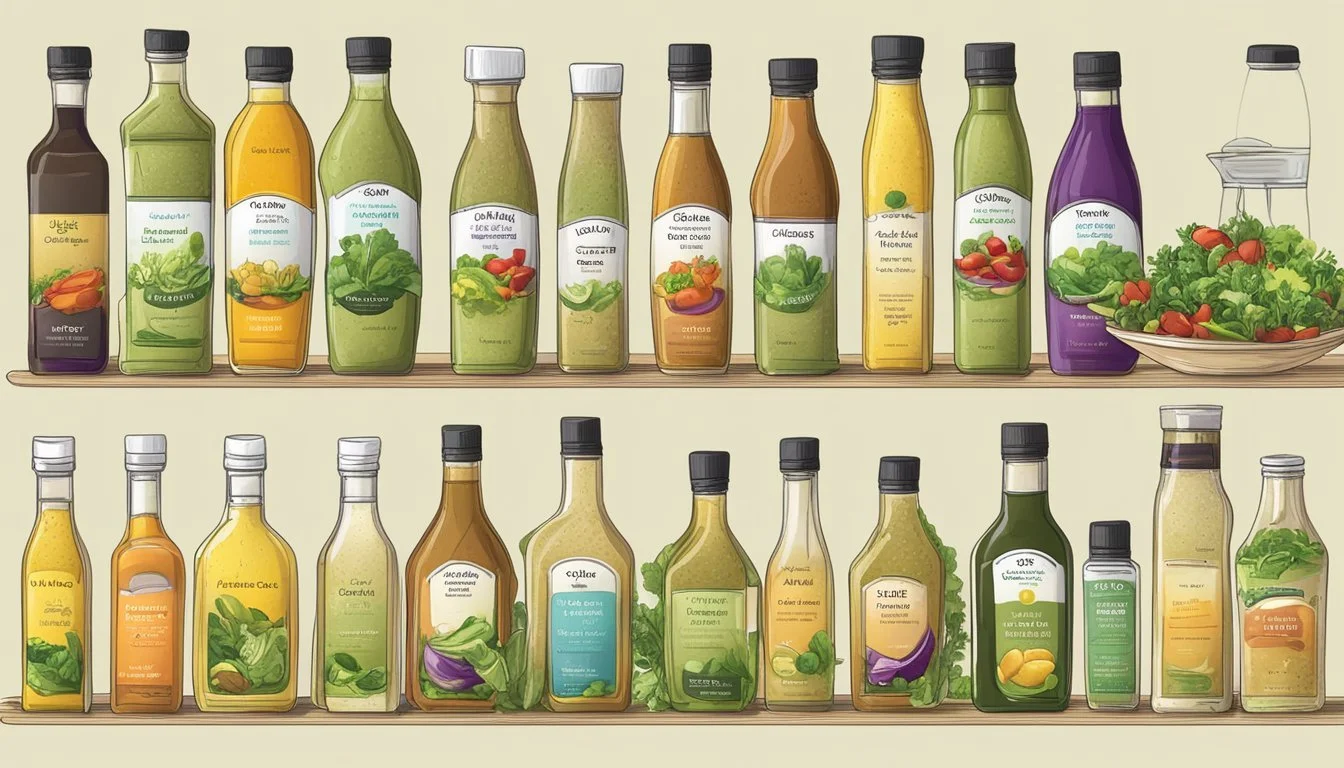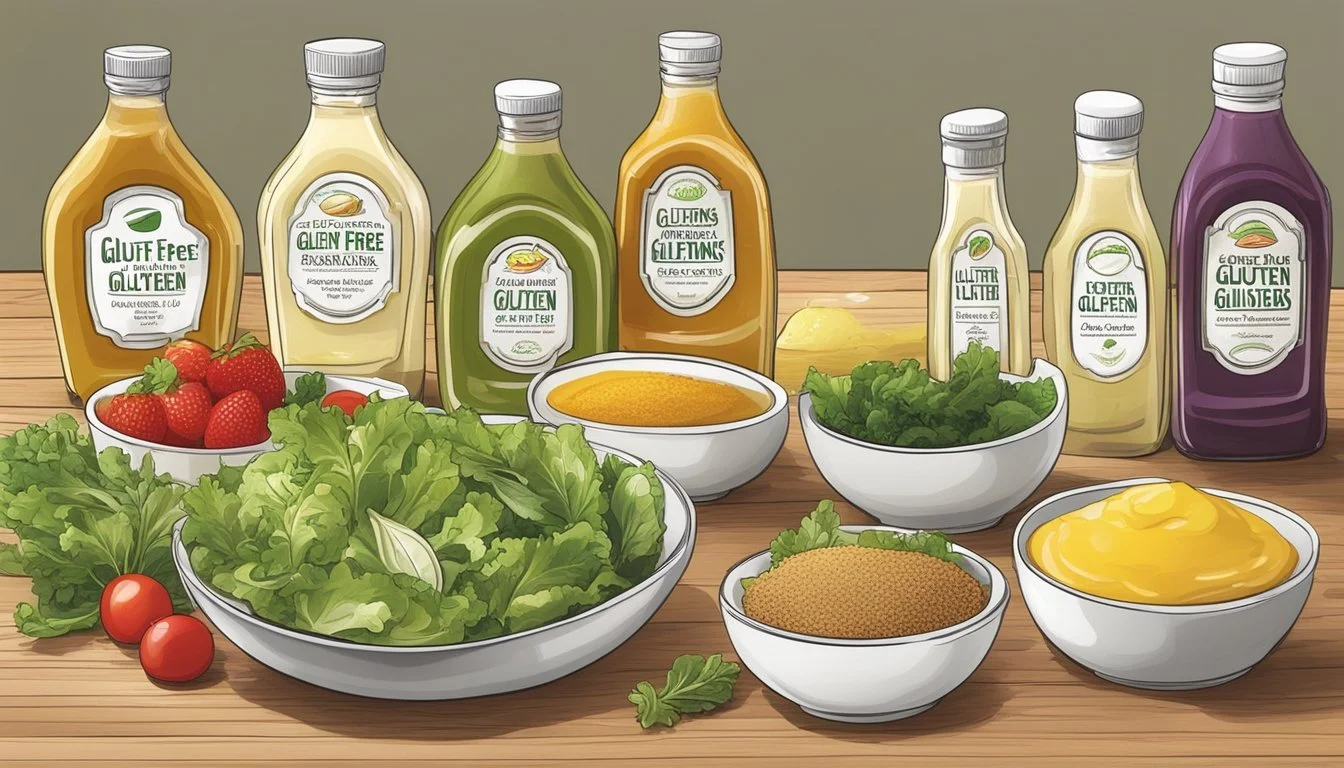Is Salad Dressing Gluten-Free?
Understanding Ingredients and Labels
When determining if salad dressing is gluten-free, it's essential to consider the ingredients and the processing environment. While many salad dressings, like mayonnaise and buttermilk-based varieties, are inherently gluten-free due to their reliance on eggs or dairy for thickening rather than wheat-based products, cross-contamination can still be a concern for individuals with celiac disease or non-celiac gluten sensitivity. Cross-contamination can occur during manufacturing if salad dressings share equipment with products containing gluten.
Moreover, dressings marketed as gluten-free often carry a label confirming their status, making it easier for consumers to make safe choices. Brands like Annie's and Primal Kitchen cater to gluten-free requirements, offering products free from grains and other gluten-containing ingredients. Consumers should always read labels carefully, as soy and other naturally gluten-free ingredients can still be at risk of cross-contamination during processing.
The availability of gluten-free salad dressings has increased in regular grocery stores. Finding suitable options is relatively straightforward with a growing awareness of gluten-related disorders and demands for gluten-free products. If specific gluten-free items are not available locally, consumers can explore specialty stores or online retailers specializing in gluten-free goods.
Understanding Gluten
In exploring whether salad dressing is gluten-free, it is essential to have a precise understanding of what gluten is and the grains it's found in.
What Is Gluten?
Gluten is a family of proteins predominantly found in certain grains. It acts as a binding agent, giving foods a stretchy quality and helping them maintain their shape. The two main proteins in gluten are gliadin and glutenin, with gliadin being responsible for most of the adverse health effects for those with gluten sensitivities.
Gluten-Containing Grains
The primary grains that contain gluten are:
Wheat: A common grain used in breads, pastas, cereals, and many processed foods.
Barley: Often found in malt, food coloring, soups, and beverages.
Rye: Typically used in rye bread, rye beer, and some cereals.
A gluten-free diet strictly excludes these grains to prevent the health issues associated with gluten consumption for those with celiac disease or gluten sensitivity. When verifying if a salad dressing is gluten-free, checking for these grains and their derivatives is critical.
Basics of Salad Dressings
Understanding the composition of salad dressings is crucial for discerning whether they are gluten-free. The ingredients and their roles are central in determining both the flavor and texture of a dressing.
Common Ingredients in Dressings
Salad dressings can vary widely in their ingredients, but most share a common set of components:
Oil: Often the principal ingredient, oils like olive, avocado, or sunflower oil provide a smooth texture and are a base for emulsification.
Vinegar: From balsamic to red wine, vinegars impart a tangy flavor and balance the oil.
Lemon juice: Offers a fresh, citrus acidity as an alternative to vinegar.
Mayonnaise: Typically gluten-free, it serves as a creamy base for many dressings.
Yogurt: Adds creaminess and tang, often used in ranch or buttermilk dressings.
Herbs and spices: Used to customize and enhance flavors.
Sweeteners: Such as honey or agave, for a touch of sweetness.
Emulsifiers: Like mustard or egg yolks, to stabilize and blend ingredients.
The Role of Base Ingredients
The base ingredients in salad dressings perform specific functions:
Oil provides the rich mouthfeel and carries flavors of other ingredients.
Vinegar or lemon juice contributes acidity which brightens flavors and can act as a preservative.
Mayonnaise and yogurt introduce a creamy consistency and can also help in emulsifying the dressing, which is the process of combining oil and water-based ingredients that usually do not mix well.
Each base ingredient influences the dressing's ultimate taste, texture, and suitability for different salad types. A balanced dressing usually includes a harmonious mix of fatty, acidic, and flavorful components.
Identifying Gluten-Free Dressings
When selecting salad dressings, individuals with gluten sensitivities must carefully identify products that are safely gluten-free. This involves meticulous label reading and understanding the certification standards.
Label Reading for Gluten-Free Products
The key to choosing gluten-free salad dressing lies in the ability to read labels effectively. Consumers should look for labels that explicitly state the product is "gluten-free", "free of gluten", "no gluten", or "without gluten". These phrases indicate that the product must meet the FDA requirement of containing less than 20 parts per million (ppm) of gluten. Ingredients to avoid include wheat, barley, rye, malt, and brewer’s yeast, all of which can contain gluten. Additionally, one should be cautious of terms like "natural flavorings" or "spices", which could potentially be sources of hidden gluten unless specified otherwise.
Examples of Common Gluten-Free Labeling Phrases:
Gluten-Free
Free of Gluten
No Gluten
Without Gluten
Ingredients to Watch for Gluten Content:
Wheat
Barley
Rye
Malt
Brewer’s yeast
Unspecified "natural flavorings"
Unspecified "spices"
Certification and Labeling Standards
For additional assurance, consumers can look for salad dressings that are "certified gluten-free" by third-party organizations. These products undergo rigorous testing and must adhere to strict guidelines, often more stringent than those set by the FDA. Certification seals, such as those from the Gluten-Free Certification Organization (GFCO), indicate the product has been tested and verified to meet specified gluten-free standards. It is important to recognize the difference between products labeled gluten-free by the manufacturer, which comply with FDA standards, and those that are certified by an independent organization, which typically follow more rigorous protocols to ensure safety for those with celiac disease and gluten sensitivities.
Recognized Gluten-Free Certification Seals:
Gluten-Free Certification Organization (GFCO)
Celiac Support Association (CSA)
National Celiac Association (NCA)
By being diligent with label reading and understanding the implications of gluten-free certifications, individuals can confidently select gluten-free salad dressings.
Risks of Cross-Contamination
Salad dressings might be a hidden source of gluten due to cross-contamination, posing risks to individuals with celiac disease or gluten sensitivity. This section examines how cross-contamination occurs and ways to prevent it in both manufacturing facilities and at-home kitchens.
Understanding Cross-Contamination
Cross-contamination occurs when gluten-free products come into contact with gluten, typically through shared facilities or equipment. For those with celiac disease, even trace amounts of gluten can trigger an immune response, damaging the small intestine. Gluten sensitivity, although not as damaging as celiac disease, can still cause significant discomfort and health issues upon ingesting gluten. It's vital in a gluten-free diet to be vigilant, particularly because cross-contamination can happen unintentionally in the journey from production to plate, especially if the manufacturing process involves shared facilities or equipment with gluten-containing products.
Preventing Cross-Contamination at Home
To avoid cross-contamination at home, individuals need to take specific steps:
Use separate cooking equipment - Designate pots, pans, and utensils for gluten-free cooking only.
Clean surfaces thoroughly - Use detergent and water to wash all surfaces before preparing gluten-free meals.
Store gluten-free items separately - Keep gluten-free products in separate, sealed containers away from gluten-containing items.
Educate household members - Make sure everyone in the home understands the importance of preventing cross-contamination.
By implementing strict measures at home and choosing products from dedicated gluten-free manufacturing facilities, individuals can minimize the risks of cross-contamination and maintain a safe gluten-free diet.
Popular Gluten-Free Dressing Types
The variety of gluten-free dressings available caters to different tastes, ensuring that salads (What wine goes well with salads?) can be enjoyed without the concern of gluten contamination. These dressings fall into two main categories: those naturally devoid of gluten and specific brands that offer gluten-free options.
Naturally Gluten-Free Dressings
Vinaigrettes, including the balsamic vinaigrette, are usually safe for those avoiding gluten, typically made of oil and vinegar. Italian dressing often follows suit, primarily consisting of vinegar, oil, and herbs. Ranch, blue cheese, and Caesar dressings can be gluten-free but require careful label inspection, as some brands may include gluten-containing additives.
Commercial Gluten-Free Brands
For those seeking store-bought dressings, brands like Organicville, Primal Kitchen, and Annie's offer an array of gluten-free dressings. They provide transparency and assurance through gluten-free labeling:
Organicville: Known for its organic dressings without artificial preservatives, including popular gluten-free flavors.
Organicville Dressings Gluten-Free Status Organic French Gluten-Free Olive Oil & Balsamic Gluten-Free
Primal Kitchen: Delivers paleo-friendly dressings made with avocado oil, ensuring a gluten-free experience.
Primal Kitchen Dressings Gluten-Free Ranch Dressing Yes Honey Mustard Vinaigrette Yes
Annie's: Offers a variety of gluten-free dressings, many of which are also vegan or dairy-free.
Annie's Dressings Gluten-Free Shiitake & Sesame Vinaigrette Yes Cowgirl Ranch Yes
When selecting commercial dressings, individuals should always read labels to ensure that there are no hidden sources of gluten, especially in dressings with a thicker consistency or added flavorings.
Preparation of Homemade Dressings
Creating homemade salad dressings is a straightforward process that allows individuals to cater to dietary restrictions like gluten intolerance. By choosing specific ingredients and following simple recipes, one can ensure their dressings are gluten-free and tailored to their taste preferences.
Simple Homemade Dressing Recipes
For those seeking gluten-free options, Vinaigrette is a go-to dressing that is both healthy and easy to make. One can mix quality oils such as extra-virgin olive or avocado oil with red wine, champagne, or balsamic vinegar for a delectable flavor. A basic vinaigrette may include:
3 parts oil (such as extra-virgin olive oil)
1 part vinegar (like balsamic or red wine vinegar)
Salt and pepper to taste
Optional additions: minced garlic, mustard, or lemon juice
Another popular choice is Caesar dressing, which can be made gluten-free by using ingredients such as:
1 cup mayonnaise
2 teaspoons anchovy paste or finely chopped anchovies (What wine goes well with anchovies?)
2 cloves garlic, minced
2 tablespoons lemon juice
1 teaspoon Dijon mustard (ensure it's gluten-free)
1/2 cup Parmesan cheese, grated (omit for vegan version)
Salt and pepper to taste
Blend all ingredients until smooth, adding milk or buttermilk if necessary to achieve desired consistency.
Ingredient Selection for Homemade Dressings
Choosing the right ingredients is crucial for making homemade dressings both gluten-free and delicious. When selecting ingredients:
Oils: Opt for high-quality, organic oils such as olive, avocado, or grapeseed oil.
Vinegars: Use naturally gluten-free vinegars like balsamic, red wine, or apple cider vinegar.
Flavorings: Enhance taste with fresh herbs, garlic, and citrus juices, all of which are naturally gluten-free.
Thickeners: For a creamier texture without gluten, xanthan gum can be added; 1/8 teaspoon is typically sufficient.
Cheese: Incorporate cheeses like Parmesan or Asiago for added flavor, ensuring they are labeled gluten-free. Vegan alternatives can include nutritional yeast for a similar cheesy profile.
Sweeteners: If sweetness is desired, choose natural sweeteners like honey or agave; however, ensure they are pure and not processed with gluten-containing substances.
Condiments: Mustards and other condiments can be included in recipes, but one must verify they are labeled gluten-free.
By carefully selecting ingredients and following recipes, homemade dressings can be tailored to be not only gluten-free but also cater to vegan diets and personal flavor preferences.
Ingredients to Watch Out For
When selecting salad dressings for a gluten-free diet, it's crucial to scrutinize the label for often overlooked sources of gluten and certain additives that may contain gluten. Recognizing these potential pitfalls can ensure the safety and enjoyment of your meal.
Hidden Sources of Gluten in Dressings
Gluten can lurk in salad dressings under various guises that may not be immediately apparent. Two common culprits include:
Soy sauce: Frequently used in vinaigrettes and Asian-inspired dressings, traditional soy sauce contains wheat. Opt for soy sauce labelled as gluten-free or for tamari, which is usually a gluten-free alternative.
Worcestershire sauce: An ingredient that can stealthily introduce gluten as it sometimes contains malt vinegar (derived from barley).
Certain dressings may also use flour as a thickener, which is not suitable for those on a gluten-free diet. Additionally, malt vinegar, made from barley, is not a gluten-free option and should be avoided.
Gluten-Derived Additives and Thickeners
The additives and thickeners in salad dressings can be hidden sources of gluten. Individuals should be vigilant about:
Modified food starch: If it's wheat-based, it contains gluten. Look for dressings that specify corn or potato as the source.
Artificial colors and flavorings: These may occasionally contain gluten, so one should ensure that the label indicates they are gluten-free.
Thickeners: Such as wheat-derived maltodextrin. Always confirm the source of any thickener.
When examining an ingredients list, be on the lookout for unspecified “flavorings” or “spices,” as these terms can mask gluten-containing ingredients. Moreover, every ingredient should be researched or verified as gluten-free, as formulations can change over time.
Alternatives to Traditional Dressings
In pursuit of gluten-free diets, individuals often seek out alternatives to traditional salad dressings. Diverse gluten-free options utilize ingredients like olive oil and vinegar, while ensuring flavors remain robust.
Exploring Gluten-Free Variants
Gluten-free dressing variants have become increasingly accessible. These dressings avoid ingredients that contain gluten, such as certain thickeners and additives commonly found in traditional dressings. Here is a list of some popular gluten-free dressings:
Vinaigrettes: A simple mixture of oil, vinegar, and seasonings.
Strawberry Balsamic Vinaigrette: Combines strawberries with balsamic vinegar, honey, and a touch of black pepper.
Classic Italian Vinaigrette: Often made with olive oil, white or red wine vinegar, garlic, and Italian herbs.
Creamy Dressings:
Ranch: Typically made gluten-free, often using a base of buttermilk or sour cream with herbs like dill and chives.
Caesar: Some brands offer gluten-free Caesar dressing, labeled as such.
Manufacturers like Organicville offer a variety of certified gluten-free salad dressings, ensuring a safer choice for those with gluten sensitivities.
Condiments and Marinades
Condiments and marinades can not only enhance the taste of a dish but also double as gluten-free dressing alternatives. One can find or create spreadable and flavorful options such as:
Mayonnaise: Egg-thickened and generally gluten-free, ideal as a base for creamy dressings or a simple spread.
Mustard: Varieties like Dijon or honey mustard can be mixed with vinegar and oil for a zesty vinaigrette.
Yogurt-based Dressings: Combine plain yogurt with herbs and spices, perfect for a lighter, creamy texture.
For those looking for a bolder taste, gluten-free marinades can impart robust flavors to salads, and are especially well-suited for protein-topped greens or vegetable salads. It is always advisable to verify the gluten-free status on labels, as some products may contain hidden gluten in additives.
Conclusion
The exploration of gluten-free salad dressings highlights a variety of safe options available to consumers adhering to a gluten-free diet.
Summing Up Gluten-Free Dressing Options
Girard's: Offers both fat-free and classic Caesar dressings labeled as gluten-free.
Annie's: Features organic dressings targeted toward a kid-friendly audience with a gluten-free label.
Primal Kitchen: Provides grain-free and dairy-free condiments and dressings for a primal diet.
Madhava: Suggests organic dressings sweetened with agave, including honey mustards and golden balsamic, suitable for those avoiding gluten.
Mayonnaise and Dairy-Based: Typically gluten-free as they do not require gluten-containing thickeners; ranch dressing is often safe.
Balsamic Vinaigrette: A universally popular gluten-free option made from balsamic vinegar, olive oil, and seasonings, offering a tangy and slightly sweet taste.
Homemade Dressings: One can whisk up gluten-free options using whole food ingredients like plain Greek yogurt for a creamy texture.
These options reflect just a portion of the gluten-free salad dressings that are available on the market or can be made at home, providing diverse choices for those on a gluten-free diet.










